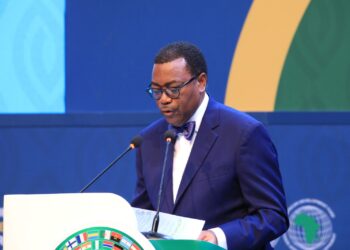About 34.3% of Nigerian workers, aged 15 and older, are working poor, living below the poverty line despite being employed.
This is according to the Nigeria Country Diagnostic Note (CDN) 2023 by the African Development Bank (AfDB), which was published on Tuesday on the bank’s website.
According to the new document, many workers in Nigeria are trapped in poverty due to low-skilled and low-wage jobs.
The document read:
- “Due to low productivity and involvement in low skilled and low-paid jobs, many workers in Nigeria are trapped in poverty. Between 2012 and 2022, the working poverty rate (those employed but are living below the poverty line) oscillated at around 35% for workers of the age of 15 or more.
- “In 2020, the working poverty rate observed a slight increase to just above 35%, attributable to COVID-19, but declined to 34.3% in 2022. Youth were the most affected by working poverty in 2019 (41.8%).”
Declining worker’s output
The output per worker fell sharply from an 8.7% growth rate in 2013 to a decrease of 0.8% in 2022. Such declining productivity not only reflects economic challenges but also suggests that many firms struggle to adjust their workforce in response to changing economic conditions.
It stated:
- “The annual growth rate of output per worker (GDP constant 2017 international dollar at purchasing power parity) declined, from 8.7% in 2013 to -5.9% in 2016 when the country entered recession due to the drop in oil prices and has remained depressed, recording a growth of -0.8% in 2022. Declining labor productivity could signal the inability of firms to adjust the number of workers even during periods of weak growth, partly attributed to strong labor unions.
- “Declining labor productivity could also be a manifestation of skill mismatch, which is a major constraint for industrial development as discussed in the next section.
- “Furthermore, the majority of Nigeria’s labor force have never attained secondary certificates, nor have ever been to school. This has adverse impacts on labor productivity.”
60% of employed Nigerians lack basic education
Education plays a crucial role in economic mobility, yet in Nigeria, it remains a significant barrier for many. According to the report, about 60% of employed Nigerians lack basic education, which consigns them predominantly to the informal sector and agricultural jobs, known for their low pay.
This situation is exacerbated by the fact that only a small fraction of the workforce achieves higher education levels, further restricting their opportunities for better employment.
It added that 41% of Nigeria’s workers were in low-skilled jobs, 28% in medium-skilled jobs, and only 31% in highly-skilled jobs.
Skill mismatches and educational inadequacies not only affect individual workers but also pose a broader challenge to the country’s economic progress.
40.1% monetary poverty rate
The report noted that there has been some progress in reducing overall poverty in Nigeria. From a high of 62.2% in 2009, the income poverty rate has dropped to 40.1%, representing 82.9 million Nigerians living below the poverty line.
This decrease reflects significant efforts and some economic improvements over the past decade. However, the poverty gap and severity remain substantial issues, with projections suggesting a potential rise in poverty due to factors like the COVID-19 pandemic, high population growth, and economic stagnation.
With an estimated annual need of N3.7 billion to eradicate poverty, focusing on educational enhancements and economic diversification will be key to lifting more Nigerians out of poverty and preventing the vulnerability that comes with economic shocks.
The report added:
- “About 40.1% (82.9 million) of Nigerians are income poor having fallen from 62.2% in 2009, meaning they had real per capita expenditure below the poverty line of 137,430 Naira per year (or 376.50 Naira per day).
- “The number of poor also dropped to 82.9 million from 102.2 million in 2009. Similarly, the poverty gap fell significantly from 26.2% to 12.9%, meaning the diminishing of the ratio by which the mean income of the poor falls below the poverty line and the severity of poverty plummeted to 5.6% compared to 2009.
- “Accounting for the absolute number of poor and the population’s size, it is estimated that the government must mobilize up to 3.7 billion Naira annually to eradicate poverty. Furthermore, some studies estimated that the number of poor rose to 92 million in 2020 and 94 million in 2021 and could potentially reach 112 million by 2030 due to a combined effect of the COVID-19 pandemic, high population growth, and economic stagnation.
- “Nigeria’s high population growth estimated at 3.5% annually fuels poverty and adds additional layers to the development challenges including rising unemployment, especially for youth. This feature demonstrates the vulnerability of Nigerians to falling into poverty when shocks occur.”




















